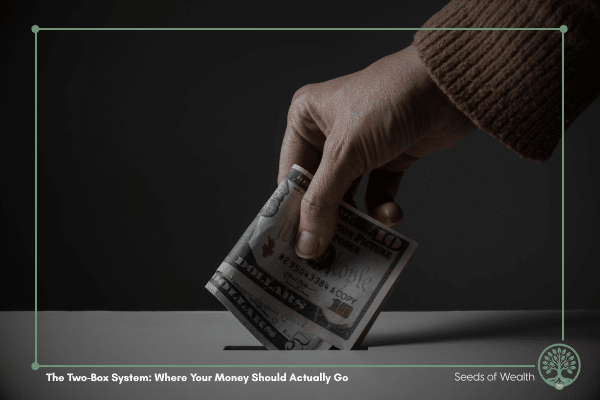The Two-Box System: Where Your Money Should Actually Go

Now that you’ve saved a dollar, or a few dozen, the question becomes: where should it go?
This is where most people stall out. They get paralyzed by options: savings accounts, investment platforms, cash envelopes, budgeting apps with more categories than a tax return. And in that fog of choice, they do what comes naturally…
Nothing.
Which is why we need to simplify—radically.
The Two-Box Method
Forget spreadsheets and dashboards for a minute. Imagine you have just two boxes:
- Box One: Spending
This is for rent, groceries, phone bills, gas, Netflix, shoes, sushi—everything you consume. - Box Two: Saving/Investing
This is for the future. Retirement. Emergency funds. That weird phase in life where the fridge breaks and your kid needs braces at the same time.
That’s it. Just two boxes.
Every dollar that comes in? It goes into one of them. No exceptions.
Why does this work?
Because clarity beats complexity. And when you can see your money split into just two categories—what you keep and what you consume—you stop lying to yourself about where it all went.
The Psychology of Visual Systems
This is more than budgeting. It’s behavior.
Studies show we’re more likely to stick to plans we can physically see. That’s why envelopes work. It’s why jars of spare change still exist.
The Two-Box method gives your money boundaries. And boundaries make grown adults act like adults—especially when it comes to spending.
Kids Get This Instantly
Give a 10-year-old two jars labeled “Spend” and “Save.” Watch how fast they start protecting that Save jar once it grows.
Adults? Same thing. We just forget because the culture teaches us to blur the line between wants and needs, spending and investing, today and tomorrow.
The Two-Box method snaps that line back into place.
How to Set Yours Up
Whether you use literal jars, bank accounts, or mental math, here’s how to start:
- Choose your boxes. (One checking, one savings works fine.)
- Decide your split. (Start with 10% to the Save box, then adjust.)
- Automate it. If your paycheck hits Friday, move your savings that day. Don’t wait to “see what’s left.” You already know how that ends.
- Reinforce it visually. Track the balance. Watch the Save box grow. Let it change how you feel about money.
Because when the Save box starts to beat the Spend box, you’ll know something’s working.
You’re not reacting to money anymore. You’re directing it.
Your Turn:
Do you know your two boxes right now?
Name them. Label them. Start using them.
You don’t need 19 budget categories. You need a simple system that makes you the boss.
Next Up:
The Wealth Ratios: How Much Should You Actually Save?
Now that you’ve got your two boxes, how do you know how much to put in each? We’ll break it down by age, stage, and strategy.

@donut @hamburglar